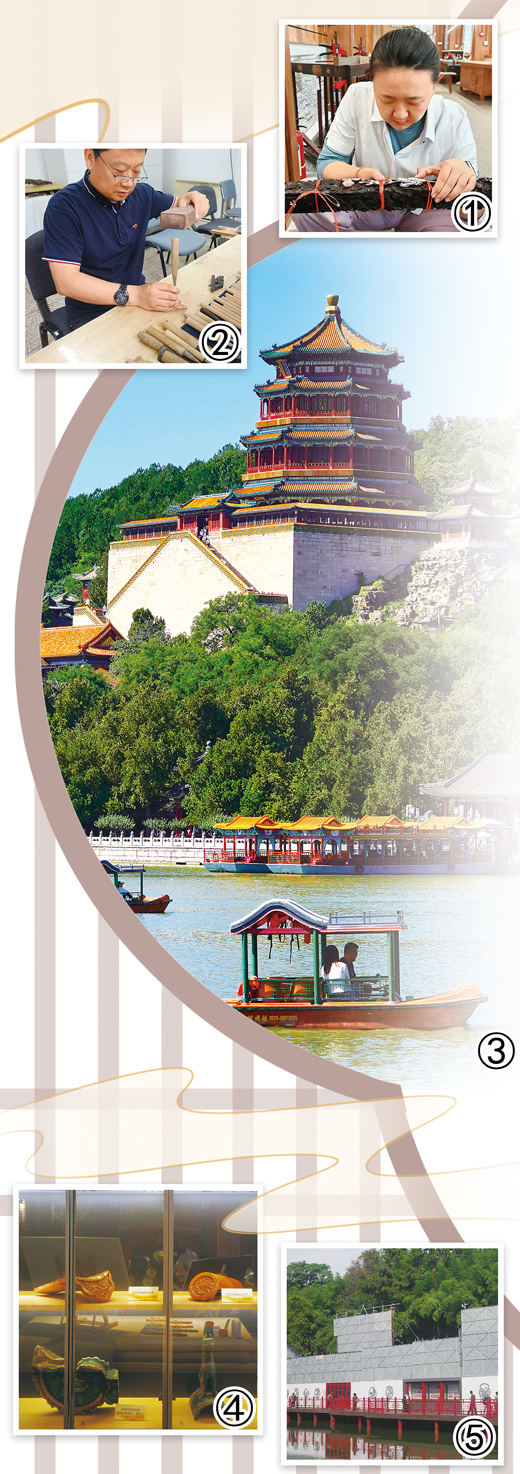




- BRNN
- BRI News
- BRNN News
- Database
Official Documents Polices and Regulations
Inter-government Documents International Cooperation BRI Countries
Business Guide Economic Data BRI Data
Trade
Investment Projects Latest projects
Cases - Content Pool

①: Zhang Quan, a cultural relic restorer, works at the Summer Palace in Beijing. (Photo courtesy of the Beijing Summer Palace Management Office)
②: Wang Xinjie, a cultural relic restorer, works at the Summer Palace in Beijing. (Photo courtesy of the Beijing Summer Palace Management Office)
③: Photo shows a beautiful autumn view of the Summer Palace in Beijing. (Photo/Song Jiaru)
④: Photo shows glazed tiles from different historical periods on display at the Summer Palace in Beijing. (People's Daily Overseas Edition/Liu Shaohua)
⑤: Photo shows fences installed during the restoration of Suzhou Street at the Summer Palace in Beijing. (People's Daily Overseas Edition/Liu Shaohua)
A dedicated team at the Summer Palace, a UNESCO World Heritage Site in Beijing, is breathing new life into centuries-old architecture and cultural relics using time-honored techniques passed down through generations.
From ancient structures and decorative paintings to furniture, silk artifacts and timepieces, these skilled craftspeople are ensuring the imperial garden's treasures endure for future generations.
Suzhou Street, one of the palace's most notable attractions, was once a royal marketplace built exclusively for the imperial family's festive celebrations during the Qing Dynasty (1644-1911). The street uniquely blends the charm of southern Chinese water towns with northern architectural styles, creating a site of significant historical, artistic and cultural value.
Suzhou Street suffered severe damage twice in the 19th century during foreign invasions. Initial reconstruction began in the 1980s under the Beijing Summer Palace Management Office. In 2024, with support from the Beijing Municipal Administration Center of Parks, a new comprehensive restoration of the street was launched.
The palace adopted an "open restoration" approach, a first for large-scale ancient building restoration projects among imperial gardens in the Beijing-Tianjin-Hebei region. This allows visitors to observe preservation work firsthand and gain deeper insight into the street's historical significance.
Chang Yunshuo from the palace's ancient architecture engineering department said original design drawings of the street, preserved at the National Library of China, proved invaluable in restoring it to its former glory.
Chang noted that the restoration follows a core principle of preserving original features while adhering to the philosophy of using original materials, designs, craftsmanship and techniques.
"We're creating a comprehensive restoration record documenting every detail," Chang said. "This ensures accountability today and provides valuable resources for future research and conservation."
The street will reopen to visitors during the 2026 National Day holiday under the three-year restoration schedule, Chang added.
The palace's ancient furniture research and restoration center houses a remarkable collection. According to Zhou Shangyun, head of the collection management center at the Beijing Summer Palace Management Office, the palace holds a vast array of historical artifacts, with furniture from the Ming (1368-1644) and Qing dynasties representing a distinctive category. The collection includes more than 1,000 pieces from the two dynasties.
As the palace's longest-established conservation workshop, the center handles the daily maintenance and restoration of furniture relics across the palace, while also caring for interior decorations, exhibition pieces and furniture displays.
Since 2016, under third-generation master Wang Xinjie's leadership, the center has completed conservation work on more than 1,000 pieces of antique furniture and wooden artifacts, making it a cornerstone of the palace's restoration efforts.
A new generation is now stepping up. Li Jijie joined the team in 2020 after completing her graduate studies, becoming the workshop's most highly educated "female carpenter." Last year, she won a silver medal in the movable cultural relic conservation category at the sixth Beijing Vocational Skills Competition. Following her success, she participated in digital cultural heritage training sessions.
"Digital technology opens up new directions for furniture restoration," said Li, who brings fresh perspectives as a young professional. "We can scan missing components, capture their patterns and use 3D printing for reproduction. This prevents damage from repeated disassembly and reduces both the difficulty and time required for manual reconstruction."
The furniture restoration work also involves collaboration with skilled artisans from beyond the palace walls. This year, three master craftsmen from Changzhou and Changshu in east China's Jiangsu Province joined forces with the center's restorers on a joint furniture restoration project launched in 2024.
Across the Summer Palace, restoration experts from various disciplines work to protect and restore cultural treasures.
Another workshop, for instance, has handled 422 collection items since 2016, covering ceramics, glassware, metalwork, jade, timepieces, lacquerware and other artifacts.
The Yangyunxuan Courtyard, reopened last year, still features structures dating back to the reign of Emperor Qianlong (1711-1799). Inside, a refined display grid showcases glazed tiles, roof ornaments and other fragments from different historical periods.
"Many artifact fragments can no longer be reused for restoration, so we preserve and display them," said Chen Qu, director of the palace's ancient architecture engineering department.
For enthusiasts of ancient architecture, these fragments hold unique value. Some pieces are rarely seen even on existing Summer Palace buildings, yet they clearly reflect the design and craftsmanship of the past.
Chen explained that throughout the revitalization and use of the courtyard, protecting historic buildings remained paramount. New partitions, lighting and decorations were installed without altering the original structure, while existing floor tiles were retained wherever possible.
The successful revitalization and use of the courtyard is now being replicated across other buildings in the palace.
"The Summer Palace has more than 800 ancient structures, which is a delightful challenge for us," said Chen, who joined the palace after graduating from Beijing Forestry University in 2003. For more than two decades, she has devoted herself to the conservation and restoration of historic architecture.

Tel:86-10-65363107, 86-10-65368220, 86-10-65363106